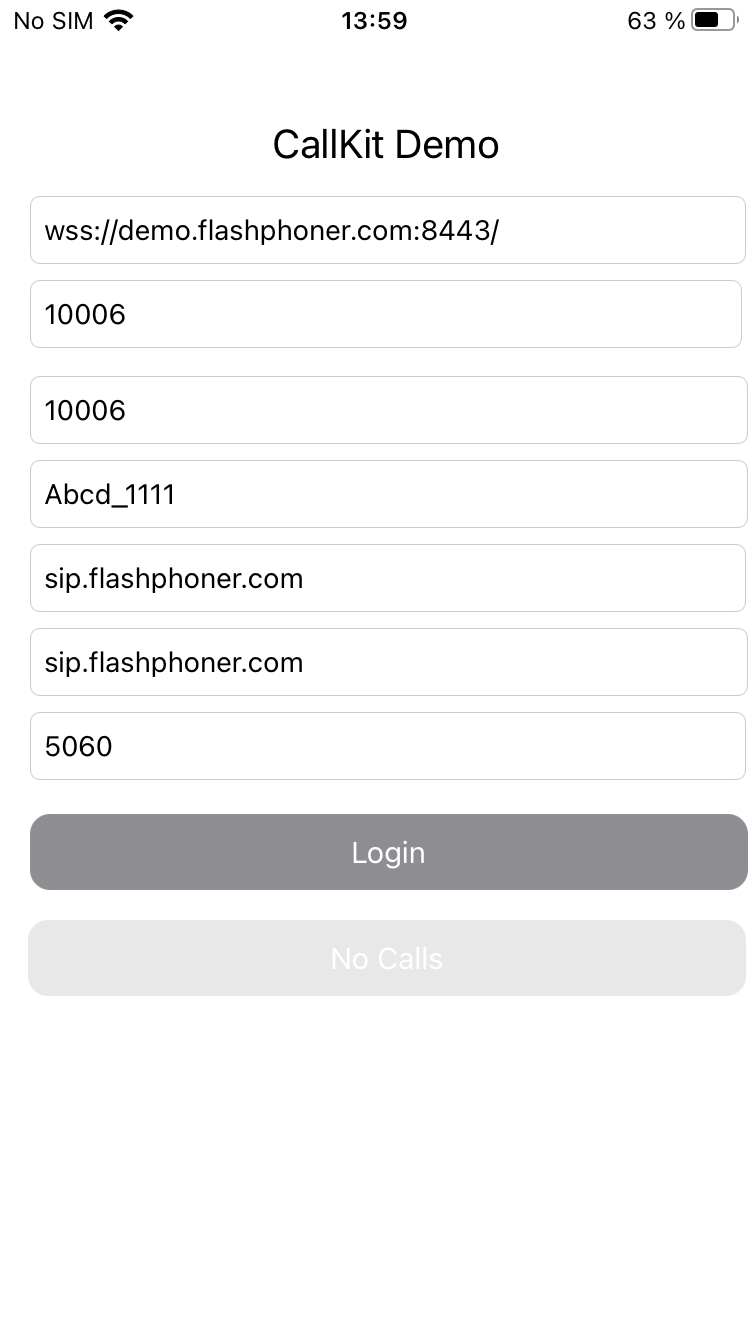iOS Call Kit Demo Swift¶
iOS application example using Call Kit to receive incoming SIP calls¶
The example shows how to use Call Kit and push notifications to receive incoming SIP calls on iOS device.
Screenshot below contains input fields for SIP session credentials

The application receives push notification about an incoming SIP call even if it is in backgound or is closed. If the application is closed, it starts, connects to the SIP session on WCS server using session token received in notification, then accepts the incoming call.
Server configuration¶
The following parameters should be set on WCS server for push notifications to work
| Parameter | Description |
|---|---|
| notification_apns_key_path | Apple Push Notification service key full name |
| notification_apns_key_id | APNs key Id |
| notification_apns_team_id | Apple developers team Id |
For example
notification_apns_key_path=/opt/apns_auth_key.p8
notification_apns_team_id=SXZF5547NK
notification_apns_key_id=7NQA96WTFZ
WCS server sends notification to APNs according to these settings when incoming SIP call is received
Analyzing the example code¶
To analyze the code, let's take CallKitDemo Swift example, which can be downloaded from GitHub
Application classes:
- class for the main view of the application:
CallKitDemoViewController(file CallKitDemoViewController.swift) - class for
CXProviderDelegateprotocol implementation:ProviderDelegate(file ProviderDelegate.swift) - class to work with UI and push registry:
AppDelegate(file AppDelegate.swift) - extension to create
CXAnswerCallActionobject by user activity, to receive the call:NSUserActivity: StartCallConvertible(file NSUserActivity+StartCallConvertible.swift) - extension to create
CXAnswerCallActionobject from application URL, to receive the call:URL: StartCallConvertible(file URL+StartCallConvertible.swift) - extension to start call implementing
INStartCallIntentHandlingprotocol (file CallKitIntentExtension/IntentHandler.swift)
1. Import of API¶
2. Connection establishing to WCS server and SIP session creation¶
FPWCSApi2.createSession code
The following parameters are passed:
urlServer- WCS server URLkeepAlive- keep the SIP session alive when client disconnectssipRegisterRequired- register the SIP session on SIP PBXsipLogin- SIP account user loginsipAuthenticationName- SIP accountuser authentication namesipPassword- SIP account passwordsipDomain- SIP PBX addresssipOutboundProxy- SIP outbound proxy address (usually the same as SIP PBX address)sipPort- SIP PBX portnoticationToken- push notification tokenappId- iOS application IdappKey- REST hook application key on WCS server
let options = FPWCSApi2SessionOptions()
options.urlServer = wcsUrl.text
options.keepAlive = true
options.sipRegisterRequired = true
options.sipLogin = sipLogin.text
options.sipAuthenticationName = sipAuthName.text
options.sipPassword = sipPassword.text
options.sipDomain = sipDomain.text
options.sipOutboundProxy = sipOutboundProxy.text
options.sipPort = Int(sipPort.text ?? "5060") as NSNumber?
let userDefaults = UserDefaults.standard
options.noticationToken = userDefaults.string(forKey: "voipToken")
options.appId = "com.flashphoner.ios.CallKitDemoSwift"
options.appKey = "defaultApp"
do {
let session = try FPWCSApi2.createSession(options)
processSession(session)
appDelegate.providerDelegate?.setSession(session)
session.connect()
} catch {
print(error)
}
3. Receiving the event about session successful creation¶
kFPWCSSessionStatus.fpwcsSessionStatusEstablished code
Session connection data should be stored to reconnect when notification is received
session.on(kFPWCSSessionStatus.fpwcsSessionStatusEstablished, callback: { rSession in
NSLog("Session established")
self.saveFields(rSession?.getAuthToken())
self.toLogoutState()
})
4. Saving WCSSession object and setting up session incoming call handlers¶
kFPWCSCallStatus.fpwcsCallStatusFinish, kFPWCSCallStatus.fpwcsCallStatusEstablished code
func setSession(_ session: FPWCSApi2Session) {
self.session = session;
session.onIncomingCallCallback({ rCall in
guard let call = rCall else {
return
}
call.on(kFPWCSCallStatus.fpwcsCallStatusFinish, callback: {rCall in
self.viewController.toNoCallState()
guard let uuid = rCall?.getUuid() else {
return
}
self.provider.reportCall(with: uuid, endedAt: Date(), reason: .remoteEnded)
})
let id = call.getId()
NSLog("CKD - session.onIncomingCallCallback. wcsCallId: " + (id ?? ""))
call.on(kFPWCSCallStatus.fpwcsCallStatusEstablished, callback: {rCall in
self.viewController.toHangupState(call.getId())
})
self.viewController.toAnswerState(call.getId())
self.currentCall = call
self.actionCall?.fulfill()
})
}
5. Describing answer call action request¶
func answer(_ callId: String) {
guard let call = self.session?.getCall(callId) else {
return
}
let callController = CXCallController()
let answerCallAction = CXAnswerCallAction(call: call.getUuid())
callController.request(CXTransaction(action: answerCallAction),
completion: { error in
if let error = error {
print("Error: \(error)")
} else {
print("Success")
}
})
}
6. Performing answer call action¶
func provider(_ provider: CXProvider, perform action: CXAnswerCallAction) {
NSLog("CKD - CXAnswerCallAction: " + action.callUUID.uuidString)
guard let call = self.session?.getCallBy(action.callUUID) else {
if (self.session?.getStatus() == kFPWCSSessionStatus.fpwcsSessionStatusDisconnected || self.session?.getStatus() == kFPWCSSessionStatus.fpwcsSessionStatusFailed) {
self.session?.connect()
}
self.actionCall = action
return
}
self.currentCall = call
action.fulfill(withDateConnected: NSDate.now)
}
7. Answering the call¶
FPWCSApi2Call.answer code
func provider(_ provider: CXProvider, didActivate audioSession: AVAudioSession) {
NSLog("CKD - didActivate \(#function)")
currentCall?.answer()
}
8. Performing end call action¶
func provider(_ provider: CXProvider, perform action: CXEndCallAction) {
NSLog("CKD - CXEndCallAction: " + action.callUUID.uuidString)
guard let call = session?.getCallBy(action.callUUID) else {
action.fulfill()
return
}
self.hangup(call.getId())
action.fulfill()
}
9. Hangup the call¶
FPWCSApi2Call.hangup code
func hangup(_ callId: String) {
guard let call = self.session?.getCall(callId) else {
return
}
call.hangup()
self.provider.reportCall(with: call.getUuid(), endedAt: Date(), reason: .remoteEnded)
}
10. Setting up token to receive notification¶
func pushRegistry(_ registry: PKPushRegistry, didUpdate credentials: PKPushCredentials, for type: PKPushType) {
if (type == .voIP) {
let token = credentials.token.map { String(format: "%02.2hhx", $0) }.joined()
NSLog("CKD - Voip token: " + token)
UserDefaults.standard.set(token, forKey: "voipToken")
}
}
11. Receiving push notification¶
func pushRegistry(_ registry: PKPushRegistry, didReceiveIncomingPushWith payload: PKPushPayload, for type: PKPushType) {
guard type == .voIP else { return }
if let id = payload.dictionaryPayload["id"] as? String,
let uuidString = payload.dictionaryPayload["uuid"] as? String,
let uuid = UUID(uuidString: uuidString),
let handle = payload.dictionaryPayload["handle"] as? String
{
NSLog("CKD - pushRegistry uuidString: " + uuidString + "; id: " + id + "; handle: " + handle)
providerDelegate?.reportIncomingCall(uuid: uuid, handle: handle, completion: nil)
}
}
12. Start audio call handler for intent extension¶
func handle(intent: INStartAudioCallIntent, completion: @escaping (INStartAudioCallIntentResponse) -> Void) {
let response: INStartAudioCallIntentResponse
defer {
completion(response)
}
// Ensure there is a person handle
guard intent.contacts?.first?.personHandle != nil else {
response = INStartAudioCallIntentResponse(code: .failure, userActivity: nil)
return
}
let userActivity = NSUserActivity(activityType: String(describing: INStartAudioCallIntent.self))
response = INStartAudioCallIntentResponse(code: .continueInApp, userActivity: userActivity)
}